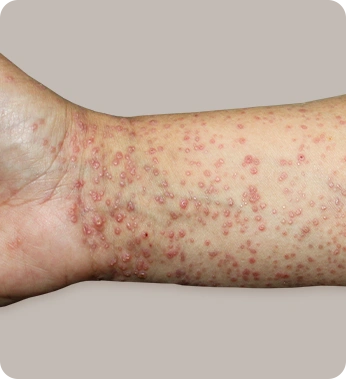
Living with Lichen Planus can be frustrating and distressing. As an autoimmune disorder, it causes your immune system to attack healthy skin cells, leading to itchy rashes, painful sores, and discomfort that make daily activities difficult. It can affect your skin, mouth, scalp, and nails, impacting eating, dressing, and even smiling. Many rely on steroid creams or immunosuppressants, only to face temporary relief and side effects.
Homeopathy treats the root cause, strengthening immunity for natural healing. At Dr Batra’s®, we have helped thousands regain comfort and confidence with personalised, research-backed homeopathy for long-term relief.
At Dr Batra’s®, we understand that lichen planus is a distressing autoimmune disorder. Being India’s largest team of homeopathic doctors, we provide gentle, safe, and long-lasting treatment that goes beyond symptom control to address the lichen planus causes. With treatment, oral lichen planus symptoms will gradually subside.
Root-Cause Healing with Homeopathy
Our treatments regulate immunity, reducing itching, inflammation, and skin lesions without side effects
Expert Care by 300+ Specialists
Our doctors specialise in autoimmune skin disorders, ensuring safe, long-term relief from lichen planus
Personalised Treatment
Every case is unique. We create personalised homeopathic plans based on your symptoms, triggers, and health history
Trusted by 15 Lakh In Patients
Decades of expertise in chronic skin care have helped thousands recover from Lichen Planus
Progress Tracking & Optimisation
Treatment is scientifically reviewed at regular intervals to ensure steady improvement and lasting results
AI-Powered Insights
Our AI-driven database analyses 15 lakh+ cases, enhancing diagnosis and optimising treatment for faster recovery
Homeopathy treats the root cause, reducing flare-ups and long-term skin damage.
Immune Balance & Inflammation Control
Homeopathic medicines help calm autoimmune overactivity, reducing flare-ups and preventing recurrences
Skin Repair & Healing
Our remedies reduce discolouration, skin thickening, and scars, helping your skin heal naturally
Itch & Discomfort Relief
We provide natural, side-effect-free relief from itching, burning, and irritation
Holistic Lifestyle Guidance
Besides homeopathic remedies, we offer diet, skincare, and stress management tips to prevent flare-ups and support overall well-being
At Dr Batra’s®, we care for your skin as much as you do!
Experience gentle, effective, and permanent relief from Lichen Planus with homeopathy.
Our treatment follows a step-by-step healing process to ensure long-term relief:
Step 1
Relief from itching, burning, and discomfort
Step 2-3
New flare ups appearing will be less
Step 4-6
Visible improvement in skin texture and reduction in flare-ups
Step 7
Stronger immunity, minimal recurrence, and long-term skin health
The healing journey varies for each patient, but steady, lasting improvement is assured.


Every patient receives a personalised remedy based on their unique symptoms and triggers.
Yes, if left untreated, lichen planus can spread to other body parts. Homeopathy helps control its progression, reduces inflammation, and prevents recurrence.
Yes, homeopathy detoxifies the body, balances immunity, and effectively treats lichen planus caused by medications, providing safe and lasting relief.
Results vary, but most patients see improvement within 6-8 weeks, with steady progress over time.
No, homeopathy is safe to take alongside allopathic medicines, including hypertension drugs, without any interference.
Homeopathy promotes natural skin healing, gradually reducing scars, discoloration, and hyperpigmentation over time.
Yes! Avoid spicy, processed foods and eat immune-boosting, anti-inflammatory foods to support healing.
No, homeopathic medicines are 100% safe, natural, and free from side effects.
Yes, homeopathy strengthens the immune system, reducing the chances of future flare-ups and ensuring long-term relief